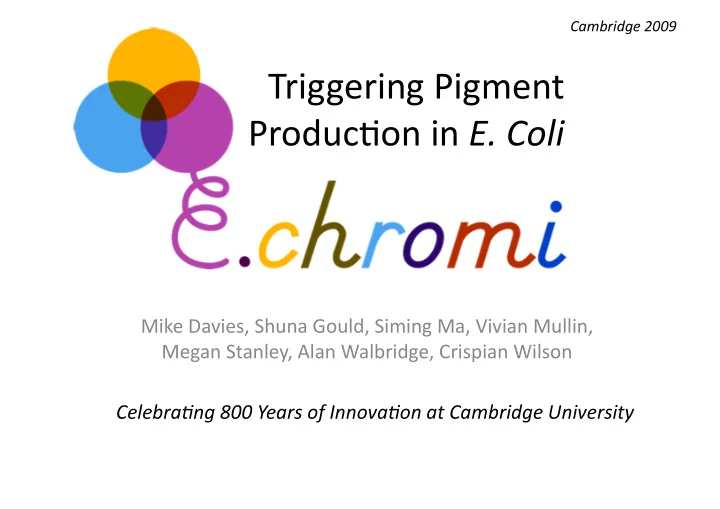

Cambridge 2009 Triggering Pigment Produc/on in E. Coli Mike Davies, Shuna Gould, Siming Ma, Vivian Mullin, Megan Stanley, Alan Walbridge, Crispian Wilson Celebra2ng 800 Years of Innova2on at Cambridge University
Cambridge 2009 The Cambridge 2009 iGEM team has created a Kit of Parts that will facilitate the design and construc1on of biosensors in the future We have developed a set of Sensi1vity Tuners and a set of Colour Generators
Cambridge 2009 Bacterial Biosensors: the Detec2on of Environmental Pollutants • Bacterial biosensors ‐ an alterna/ve to chemical methods • S/ll selec/ve and sensi/ve • Inexpensive • Less labour intensive • More accessible
Cambridge 2009 Bacterial Biosensors: Problems Bacterial Biosensors: Solu2ons R R S S C C T T E E E O E O P P U U N N L L O O N N R S S R O O E E T T O O U U R R E E R R R R R R Lack of self‐contained output Inability to tune sensor as SensiHvity Tuners Colour Generators desired – Limited by sensi/vity of – PoPS converters – Reliance on reporters in – Bacterial pigments promoter – Change sensi/vity of Registry – Visible, user‐friendly output – Limited to PoPS output upstream promoter – Require addi/onal behaviour of promoter technology to read output
Cambridge 2009 Bacterial Biosensors: Easy to use S C T E O U N L N S O E O U R R R
Cambridge 2009 Bacterial Biosensors: A prototype Inducer concentra/on: 0 low high The colour readout indicates concentra/on of inducer
Cambridge 2009 Bacterial Biosensors: How to build a bacterial biosensor with these parts Pigment Chemical IN OUT COLOUR SENSOR SENSITIVITY TUNER GENERATOR Input SENSOR T PoPS SENSITIVITY PoPS TUNER Phage Input PoPS COLOUR Ac/vator Promoter Pigment Receiver ac/vator GENERATOR PoPS PoPS sensi/ve to sensi/ve producing Converter promoter input device PoPS Colour Reporter
Cambridge 2009 SensiHvity Tuners: Introduc2on Rate of Output • A Sensi/vity Tuner allows adjustment of sensi/vity to input Concentra/on • A combina/on of different Tuners in parallel allow measurements of a range of discrete input concentra/ons
Cambridge 2009 Design: an Input to Output Device PoPS in PoPS out T Phage Ac/vator ac/vator sensi/ve promoter Ac/vator PoPS in Transcrip/onal and Concentra/on PoPS out Promoter Transla/onal Characteris/cs Characteris/cs
Cambridge 2009 Previous Work: Cambridge 2007 T I0500 Phage Ac/vator I13504 I13507 pBad/AraC ac/vator sensi/ve GFP mRFP promoter “Amplifiers” ac/vators • GFP output controlled by phage P2 ogr PSP3 pag phiR73 delta promoter PF promoter I746370 I746380 I746390 promoters PO promoter I746371 I746381 I746391 • RFP output controlled by pBad PP promoter I746372 I746382 I746392 input Psid promoter I746374 I746384 I746394 PLL promoter I746375 I746385 I746395 • Characterized as an “amplifier” by ra/o of RFP to GFP
Cambridge 2009 SensiHvity Tuners: Modelling Arabinose Ac/vator GFP PoPS in Phage Ac/vator Phage Ac/vator GFP GFP pBAD pBAD Phage Phage Conc. Conc. PoPS out Conc. Transcrip/on & Transcrip/on & Transcrip/on Transcrip/on Promoter Promoter Promoter Promoter Transla/on Transla/on & Transla/on & Transla/on Characteris/cs Characteris/cs Characteris/cs Characteris/cs Characteris/cs Characteris/cs Characteris/cs Characteris/cs Model gene characteris/cs at steady • where state using Law of Mass Ac/on pBAD is repressed by repressor X* • which binds to arabinose • Assume transcrip/on and transla/on are linear func/ons of PoPS Model protein concentra/ons as • dynamic, since these change slowly Allow for protein degrada/on •
Cambridge 2009 Modelling Results: Sigmoidal Behaviour • The model contains a large number of constants • A priori modelling requires arbitrary values to be chosen • Maximum reporter produc/on rate is sigmoidal with inducer concentra/on Reporter Degradation rates at multiple input Model for maximum fluorescence rate concentrations of arabinose Reporter production rate Reporter production rate Inducer concentration time
Cambridge 2009 Curve FiTng: Hill Func2on A model Sensitivity Tuner Peak rate 1 RPU Rate of GFP expression Hill coefficient Increase in rate (a) (n) Basal rate (c) Half‐maximal induc/on (k) Concentra/on of Arabinose
SensiHvity Tuners: Changing the Cambridge 2009 sensi2vity of an upstream promoter • Constructs were tested on high copy against pBAD characteris/cs • Output triggered at much lower arabinose concentra/on when Sensi/vity Tuner included pBAD -> GFP pBAD -> Construct 91 -> GFP Maximum normalised GFP Maximum normalised GFP production production Arabinose concentraion ( µ m) Arabinose concentraion ( µ m)
Cambridge 2009 SensiHvity Tuners: Characterisa2on • 15 Cambridge 2007 constructs moved down to low copy plasmid • High throughput tes/ng • 3 repeats of 3 colonies over 8 concentra/ons • OD and fluorescence P2 ogr PSP3 pag phiR73 delta measured PF promoter I746370 I746380 I746390 PO promoter I746371 I746381 I746391 • Standard Promoter included PP promoter I746372 I746382 I746392 on plate to allow for RPU Psid promoter I746374 I746384 I746394 PLL promoter I746375 I746385 I746395 measurements
Cambridge 2009 SensiHvity Tuners: SoLware • Matlab graphical interface developed to allow data to be viewed in several ways • Standard promoter data allows for RPU characterisa/on
Cambridge 2009 Curve FiTng: Hill Func2on • Non‐linear least squares method used to fit Hill func/ons to measured data • Each fit produces the parameters of the Hill func/on, enabling construct to be quan/ta/vely analysed
Cambridge 2009 SensiHvity Tuners: Parameters • A range of Sensi/vity Tuners were successfully characterised on low copy • Good range in sensi/vity: 10x range in half‐maximal induc/on • Hill coefficients of 2 – 3 when concentra/on resolu/on is sufficient • Wide range of rate increases, from 0.3RPU to 1.2RPU A model Sensitivity Tuner Peak rate 1 RPU Hill Rate of GFP expression coefficient Increase in rate (a) (n) Basal rate (c) Half‐maximal induc/on (k) Concentra/on of Arabinose
Cambridge 2009 SensiHvity Tuners: Design • A standard kit was designed using well characterised candidates • Tuners can be used with any promoter • Any device can be placed downstream of the construct P2 ogr PSP3 pag phiR73 delta PF promoter K274370 K274380 PO promoter K274371 K274381 K274391 T PP promoter K274382 K274392 ac/vator promoter Psid promoter K274374 K274384 K274394 PLL promoter K274375 K274395
Recommend
More recommend